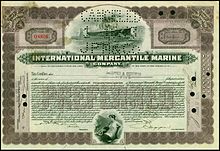International Mercantile Marine Company
The International Mercantile Marine Company (IMMC) was a US shipping company based in New York City whose main business purpose was to maintain a liner service between North America and Europe. The initiator of the IMMC was the American banker, railroad magnate and businessman John Pierpont Morgan , who once said: "If you have to ask about the price of a yacht, you can't afford one".
history
Morgan's attack on shipping began in 1900 when he was at the peak of his success. His bank had assets of $ 162 million and his railroad company, the Baltimore and Ohio Railroad , owned a network of 15,000 km between the Atlantic coast and Chicago. His plan for shipping was remarkably simple: take over all the major shipping companies in the world and then connect the ships to his railroad network.
Morgan, along with a group of shareholders, provided $ 20 million to buy up the two major American shipping companies, Atlantic Transport Line (ATL) and the International Navigation Company . In this way Morgan came into possession of about 40 ships, mostly freighters. After that, Morgan focused on the UK. In April 1901, $ 12 million was paid in cash for the Leyland Line shipping company , the largest transatlantic freighter line with its 40 ships. Just 10 months later, he bought the White Star Line and its eight passenger liners for $ 40 million in cash and shares . In addition, Morgan acquired Dominion Line Ltd. for $ 4.5 million with their 6 passenger and cargo ships.
In just one year, Morgan and his partners had acquired a fleet of about 100 ships, about a third of the tonnage that ran between Europe and North America. The European press railed against this morganization of the Atlantic, but it was difficult for the board of directors of the shipping companies to ignore Morgan's offers to buy. At the beginning of 1902, the two large German shipping companies, the Hamburg-American Packetfahrt-Actien-Gesellschaft (HAPAG; also called Hamburg-America Line / HAL) and the North German Lloyd (NDL) in Bremen, signed a 10-year contract Morgan's company. While they did not want to sell, they still had a common policy with Morgan to avoid undue competition.
In April 1902 Morgan announced the formation of a holding company, the International Mercantile Marine Company (IMMC), with capital of $ 170 million. This number came about in part by taking into account future stock value, which was extremely optimistic.
But not all shipping companies wanted to be bought by Morgan. The prestigious British Cunard Line refused, and its president put pressure on Parliament until it approved a loan of $ 11,712,000 to build new ships, plus annual subsidies of $ 732,000. This open resistance gave courage to another important shipping company, the then state-owned French Compagnie Générale Transatlantique SA (CGT) with its 75 passenger and cargo ships, was deaf to Morgan's offers.
With this, Morgan's plan for a monopoly on the Atlantic got into trouble. The IMMC got into tough and costly competition and increasingly had to order new ships for the subsidiaries in order to improve the market situation.
When Morgan lost interest in the company, the IMMC began to suffer from bad management and went bankrupt in 1915. But the First World War, with its demand for ships, saved society from ruin. In the 1920s , the company focused on its US shipping companies and parted with their overseas acquisitions. In 1922, the IMMC changed its name to United States Lines Inc. (USL) and survived as one of the most successful and profitable US shipping companies until it went bankrupt in 1987.
Web links
- "The 'Titanic stocks', Rose and the second maid" shows all previously known share certificates and bonds of the IMM as well as other financial historical documents on the subject.
